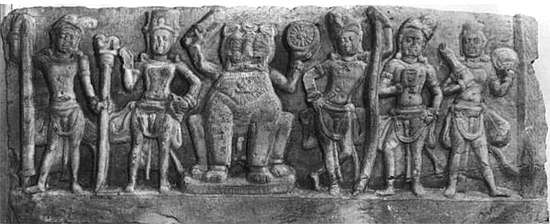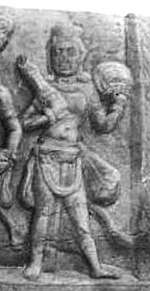Aniruddha
Aniruddha or Aniruddh (Sanskrit: अनिरुद्ध aniruddha), meaning "unrestrained", "without obstacles" or "unstoppable" was the son of Pradyumna and Rukmavati and the grandson of Krishna and Rukmini.[1] He is said to have been very much like his grandfather, to the extent that he may be a jana avatar, the avatar of Vishnu. The four are considered to be Vishnu-tattva or Vishnu's plenary expansions. It has been also used as one of the names of Lord Shiva.
| Aniruddha | |
|---|---|
 Aniruddha and Usha | |
| Devanagari | अनिरुद्ध |
| Texts | Bhagavat Purana, Vishnu Purana, Shiva Purana, Mahabharata |
| Personal information | |
| Parents |
|
| Spouse | Rochana Usha |
| Children | Vajra |
| Dynasty | Yadava |
| Vrishni heroes |
|---|
 |
Marriage to Rochana
Aniruddha's marriage to Rochana is described in the 61st Chapter of the 10th Canto of the Bhagavata Purana.[2] Rukmi requested Krishna and Rukmini to have Aniruddha marry Rochana, Rukmi's granddaughter. When the marriage ceremony was arranged, Rukmi was killed by Lord Balarama after the former tried to insult the latter by cheating in a game of Pagade (dice).
Marriage to Usha

As per Srimad Bhagavatam, a Daitya princess named Usha, daughter of Banasura (sometimes called Bana), fell in love with Aniruddha in her dream.[4] As per the artistic description of Usha's dream, Chitralekha, her friend, drew pictures of many princes. Usha recognized Aniruddha among them. Chitralekha brought Aniruddha by her magic influence to Usha's palace in the latter's father's city of Sonitpura in Assam. However, according to some legends, Shonitpur is also identified with Sarahan in the Shimla district of Himachal Pradesh. Going by their legends, Pradyumna was made the king of Shonitpur & subsequently the Bushahr state by Lord Krishna himself. Banasura sent guards to seize him, but the valiant youth, taking an iron club, slew his assailants. Banasura then brought his magic powers to bear and secured him.
On discovering that Aniruddha had been carried away, Krishna, Balarama, and Pradyumna went to rescue him. Banasura was a great devotee of the god Shiva and had 1000 arms, as a result of which no one had ever been willing to fight him. Blinded by his pride, he asked Shiva to give him a chance to fight with someone as strong as himself. Shiva, therefore, scolded him that he would be defeated in war and his arrogance would be destroyed.
.jpg)
After a month, Krishna came to know where his grandson was, after Narada told him. The Yadus launched an attack on Banasura with their army. Thus a great battle was fought. (See Canto 10, Chapter 63 of Srimad Bhagavatam)[5]
When the army laid siege to his city, Banasura staged a fierce counter-attack. At this point, Shiva joined the battle against Krishna because he had promised protection to Banasura. Krishna himself defeated Shiva with a weapon that put Shiva to sleep. After many of his warriors were defeated, Bana took up arms against Krishna. Krishna fought back with his powerful weapon Sudarshana Chakra and kept on chopping off one arm after another of Bana till he was left with only four arms. After this Shiva came and requested Lord Krishna not to kill Bana. Then Lord Krishna replied,
"Prahlada and his descendent King Bali were devoted to me. I promised Bali that I shall not kill anyone in his family. Therefore I cannot kill Bana. But I have arrived here to humble him. The four arms that are left with will enable him to rule over his kingdom. I have destroyed his army so that weight of the earth is lessened. I assure Bana that he'll not be killed".
In gratitude, King Bana bowed to lotus feet of Krishna.
Boar symbol
%2C_Gupta_period%2C_mid-5th_century_AD._Boston_Museum.jpg)
In Vaishnavism, Aniruddha is associated with the boar, which is his theriomorphic aspect, also known as Varaha.[8][9][6] Aniruddha appears as a boar in some of the Caturvyūha statues, where he is an assistant to Vāsudeva, and in the Vaikuntha Chaturmurti when his boar's head protrudes from the side of Vishnu's head.[6]
Aniruddha is also associated with the qualities of ferociousness and sovereignty.[10]
Family
Aniruddha was married to Usha after Krishna forgave Banasura, and together, they had a child - Vajranabha (Vajra). Pradyumna and Aniruddha died in the intoxicate brawl between the Yadavas, which claimed the life of every Yadava prince, except Vajra who was the only survivor. Arjuna took the Yadava wives and the other survivors (older family members) to the city of Indraprashta, and crowned Vajra as the king.[11]
Rebirth
According to Shiva Purana, Annirudha and Usha reborn again as Lakshindar and Behula and in next life married each other again.[12]
In literature
The story of Aniruddha and Usha (as Okha in Gujarati, also "Ukha" in Assamese) is depicted in the 18th century Gujarati Akhyana entitled Okhaharan by Premanand Bhatt.[13]
A 1901 Telugu language play titled Usha Parinayam written by Vedam Venkataraya Sastry was based on his love story with Usha.[14]
Aniruddha, which means "unstoppable," is also another name of Vishnu.
External links
References
- Gopal, Madan (1990). K.S. Gautam (ed.). India through the ages. Publication Division, Ministry of Information and Broadcasting, Government of India. p. 68.
- "Srimad Bhagavatam: Canto 10 - Chapter 61". Bhagavata.org.
- Gupta, Vinay K. "Vrishnis in Ancient Literature and Art". Indology's Pulse Arts in Context, Doris Meth Srinivasan Festschrift Volume, Eds. Corinna Wessels Mevissen and Gerd Mevissen with Assistance of Vinay Kumar Gupta: 74–75.
- "Srimad Bhagavatam: Canto10 - Chapter 62". Bhagavata.org.
- "Srimad Bhagavatam: Canto 10 - Chapter 63". Bhagavata.org.
- Srinivasan, Doris (1979). "Early Vaiṣṇava Imagery: Caturvyūha and Variant Forms". Archives of Asian Art. 32: 39–54. ISSN 0066-6637. JSTOR 20111096.
- For English summary, see page 80 Schmid, Charlotte (1997). Les Vaikuṇṭha gupta de Mathura : Viṣṇu ou Kṛṣṇa?. pp. 60–88.
- "The glorious Aniruddha should be Varaha who rescued the Earth" in Rangarajan, Haripriya (1997). Varāha Images in Madhya Pradesh: An Iconographic Study. Somaiya Publications. p. 38. ISBN 978-81-7039-214-9.
- "Aniruddha (is represented) by his theriomorphic form, the boar" in Srinivasan, Doris (1997). Many Heads, Arms, and Eyes: Origin, Meaning, and Form of Multiplicity in Indian Art. BRILL. p. 254. ISBN 978-90-04-10758-8.
- "Gentleness and strength are associated with Vasudeva, "knowledge with Samkarsana, (Narasimha) female power with Pradyumna (Varaha) and ferociousness and sovereignty with Aniruddha (Kapila)." Kamalakar, G.; Veerender, M. (1993). Vishnu in Art, Thought & Literature. Birla Archeological & Cultural Research Institute. p. 92.
- "Srimad Bhagavatam: Canto 11 - Chapter 63". Bhagavata.org.
- McDaniel, June (5 August 2004). Offering Flowers, Feeding Skulls: Popular Goddess Worship in West Bengal. Oxford University Press. ISBN 978-0-19-029056-6.
- Sen, Siba Pada (1988). Sources of the History of India. Institute of Historical Studies.
- Leiter, Samuel L. (2007). Encyclopedia of Asian Theatre: A-N. Greenwood Press. ISBN 978-0-313-33530-3.
- Dowson: Classical Dictionary of Hindu Mythology.
